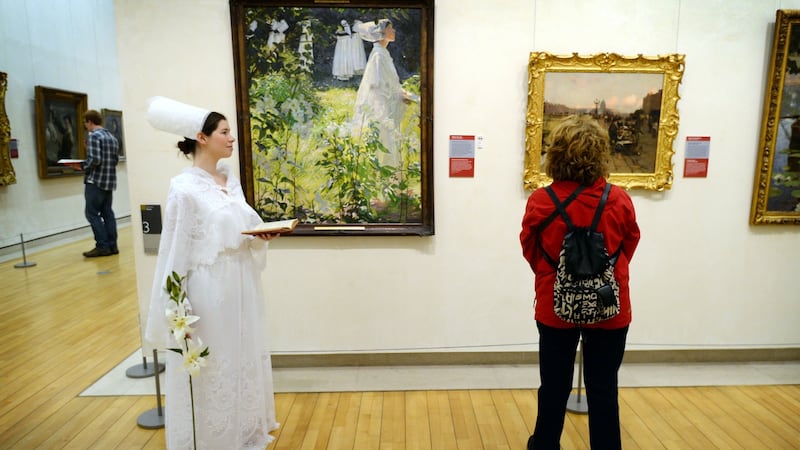Charlie Minter is head of the Irish art department at Sotheby's, the international auction house with a network of 90 offices in 40 countries, including 29 Molesworth Street in Dublin.
What’s your area of expertise?
My area of expertise covers British and Irish art from the mid-19th century to the present day. In the past few years I have been focusing increasingly on Irish art and in 2015 I led the reintroduction of our standalone Irish art sale, which included a successful travelling exhibition at the

Royal Hibernian Academy
in Dublin. At the auction in London in October, the highest price achieved was for
Japanese Switzerland
by Sir
John Lavery
, which sold for £509,000 (about €693,000), at the top end of its estimate (£300,000-£500,000).
The painting, dating from 1912, depicts the artist’s wife, Hazel, Lady Lavery, and stepdaughter Alice, in the Swiss Alps. It had been consigned by the family who had bought it – also at Sotheby’s – in 1996 for £150,000.
What do you do?
My job has taken me across Ireland, through the towns and landscapes that have inspired the artworks we handle, and it’s been an amazing journey of discovery thus far. A picture always has a story to tell and I’ve enjoyed listening to many a good story over a cup of Barry’s. It’s always fascinating to learn the history of the works and often one feels never more than a step away from the artist. And now that our sales are focusing on contemporary art again, it’s a pleasure to deal with artists directly as well. Sotheby’s next Irish art sale will take place in London on September 13th, 2016, and I’ll be visiting Ireland next month to undertake valuations.
What’s your background?
I graduated from
Durham University
with a first-class degree in theology (another subject that fascinates me, and with some useful crossovers). I worked for a London art gallery before my career at Sotheby’s, which gave me good experience of the dealer side of the business.
This is a big year for me: I am getting married in October, once the Irish art sale is over. My fiancée, Alice Bleuzen, is from France, so I'm brushing up my French alongside finding the next great Irish picture.
How did you get into the business?
I have been at Sotheby’s for six years. After graduating from university I was eager to pursue a role in the art world. I was immediately hooked by the buzz of the auction place and the array of artworks we are lucky enough to handle. I was thrilled to gain my position in the British and Irish art department and I’ve been enjoying it ever since.
What advice would you give collectors/ investors?
There’s no place quite like the auction world: buying art involves an emotional and financial commitment; it’s rarely one without the other. I think it’s therefore important to buy what you like, but also to know what you’re buying. Is it a good example by the artist? Is it sensibly priced? How is the market performing?
I would advise attending auctions, visiting galleries, speaking to experts and discovering what you do and don’t like. The more you explore the subject, the more you are likely to gain from it, and there’s really nothing quite like the joy of owning your own piece of art.
The Irish art market is currently at an interesting place. There is a definite sense confidence is returning to the market so I think right now there are opportunities to be had.
Career highlights?
A great aspect of the job is the unexpected. You never know who’s going to be on the end of the telephone or what you’ll see behind a door. On that note, there was one memorable occasion recently when I went to visit a client with a couple of small Irish pictures. Out of the corner of my eye I spotted a rare and unique sculpture by British sculptor Lynn Chadwick. The piece, entitled
Stabile With Mobile Element
, had been acquired directly from the artist by the owner’s late husband in 1954 – two years after its creation – and it was unknown in the art world. The client was such a pleasure to work with and it was an amazing journey going from that moment of discovery to the day of the auction. The sculpture sold last year at Sotheby’s in London for £749,000. I shan’t ever forget that.
What do you personally collect and why?
This job is a tease, as you handle so many beautiful things that you know you will never have. I have bought a few little things over the years that have caught my eye, but no big names. I’d love an early Orpen sketch: one day, perhaps.
What would you buy if money were no object?
I was rather taken with
Kinsale
on my Irish travels last summer: a little cottage there overlooking the sea sounds good, and then I’d fill it with lovely pictures and sculptures . . . Irish, of course.
What’s your favourite work of art
? An impossible question
. . . I remember first encountering William Leech's A Convent Garden, Brittany at the National Gallery of Ireland and being dazzled by it. Plus my fiancée is from Brittany, so I can imagine the figure is her.





















